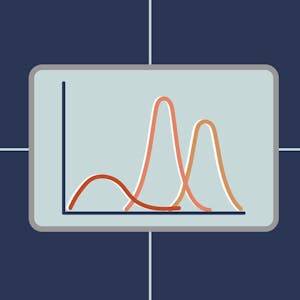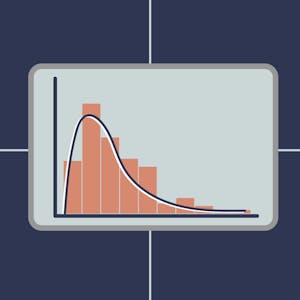Table of Contents
Best Bayesian Statistics Courses 2021
Bayesian Statistics: From Concept to Data Analysis
This course introduces the Bayesian approach to statistics, starting with the concept of probability and moving to the analysis of data. We will learn about the philosophy of the Bayesian approach as well as how to implement it for common types of data. We will compare the Bayesian approach to the more commonly-taught Frequentist approach, and see some of the benefits of the Bayesian approach. In particular, the Bayesian approach allows for better accounting of uncertainty, results that have more intuitive and interpretable meaning, and more explicit statements of assumptions.
This Bayesian Statistics course combines lecture videos, computer demonstrations, readings, exercises, and discussion boards to create an active learning experience. For computing, you have the choice of using Microsoft Excel or the open-source, freely available statistical package R, with equivalent content for both options. The lectures provide some of the basic mathematical development as well as explanations of philosophy and interpretation. Completion of this course will give you an understanding of the concepts of the Bayesian approach, understanding the key differences between Bayesian and Frequentist approaches, and the ability to do basic data analyses.
Bayesian Statistics: Techniques and Models
This is the second of a two-course sequence introducing the fundamentals of Bayesian statistics. It builds on the course Bayesian Statistics: From Concept to Data Analysis, which introduces Bayesian methods through use of simple conjugate models. Real-world data often require more sophisticated models to reach realistic conclusions. This course aims to expand our “Bayesian toolbox” with more general models, and computational techniques to fit them. In particular, we will introduce Markov chain Monte Carlo (MCMC) methods, which allow sampling from posterior distributions that have no analytical solution.
We will use the open-source, freely available software R (some experience is assumed, e.g., completing the previous course in R) and JAGS (no experience required). We will learn how to construct, fit, assess, and compare Bayesian statistical models to answer scientific questions involving continuous, binary, and count data. This course combines lecture videos, computer demonstrations, readings, exercises, and discussion boards to create an active learning experience. The lectures provide some of the basic mathematical development, explanations of the statistical modeling process, and a few basic modeling techniques commonly used by statisticians. Computer demonstrations provide concrete, practical walkthroughs. Completion of this Bayesian Statistics tutorial will give you access to a wide range of Bayesian analytical tools, customizable to your data.
Duke University Bayesian Statistics
This course describes Bayesian statistics, in which one’s inferences about parameters or hypotheses are updated as evidence accumulates. You will learn to use Bayes’ rule to transform prior probabilities into posterior probabilities, and be introduced to the underlying theory and perspective of the Bayesian paradigm. The course will apply Bayesian methods to several practical problems, to show end-to-end Bayesian analyses that move from framing the question to building models to eliciting prior probabilities to implementing in R (free statistical software) the final posterior distribution. Additionally, the course will introduce credible regions, Bayesian comparisons of means and proportions, Bayesian regression and inference using multiple models, and discussion of Bayesian prediction.
We assume learners in this course have background knowledge equivalent to what is covered in the earlier three courses in this specialization: “Introduction to Probability and Data,” “Inferential Statistics,” and “Linear Regression and Modeling.”
Bayesian Machine Learning in Python: A/B Testing
This course is all about A/B testing.
A/B testing is used everywhere. Marketing, retail, newsfeeds, online advertising, and more.
A/B testing is all about comparing things.
If you’re a data scientist, and you want to tell the rest of the company, “logo A is better than logo B”, well you can’t just say that without proving it using numbers and statistics.
Traditional A/B testing has been around for a long time, and it’s full of approximations and confusing definitions.
In this course, while we will do traditional A/B testing in order to appreciate its complexity, what we will eventually get to is the Bayesian machine learning way of doing things.
First, we’ll see if we can improve on traditional A/B testing with adaptive methods. These all help you solve the explore-exploit dilemma.
You’ll learn about the epsilon-greedy algorithm, which you may have heard about in the context of reinforcement learning.
Best Bayesian Statistics Books 2021
Bayesian Statistics The Fun Way: Understanding Statistics And Probability With Star Wars, Lego, And Rubber Ducks
- Book - bayesian statistics the fun way: understanding statistics and probability with star wars,...
- Language: english
- Binding: paperback
Fun guide to learning Bayesian statistics and probability through unusual and illustrative examples.
Probability and statistics are increasingly important in a huge range of professions. But many people use data in ways they don’t even understand, meaning they aren’t getting the most from it. Bayesian Statistics the Fun Way will change that.
This book will give you a complete understanding of Bayesian statistics through simple explanations and un-boring examples. Find out the probability of UFOs landing in your garden, how likely Han Solo is to survive a flight through an asteroid shower, how to win an argument about conspiracy theories, and whether a burglary really was a burglary, to name a few examples.
By using these off-the-beaten-track examples, the author actually makes learning statistics fun. And you’ll learn real skills, like how to:
– How to measure your own level of uncertainty in a conclusion or belief
– Calculate Bayes theorem and understand what it’s useful for
– Find the posterior, likelihood, and prior to check the accuracy of your conclusions
– Calculate distributions to see the range of your data
– Compare hypotheses and draw reliable conclusions from them
Next time you find yourself with a sheaf of survey results and no idea what to do with them, turn to Bayesian Statistics the Fun Way to get the most value from your data.
Doing Bayesian Data Analysis: A Tutorial with R, JAGS, and Stan
- Hardcover Book
- Kruschke, John (Author)
- English (Publication Language)
Doing Bayesian Data Analysis: A Tutorial with R, JAGS, and Stan, Second Edition provides an accessible approach for conducting Bayesian data analysis, as material is explained clearly with concrete examples. Included are step-by-step instructions on how to carry out Bayesian data analyses in the popular and free software R and WinBugs, as well as new programs in JAGS and Stan. The new programs are designed to be much easier to use than the scripts in the first edition. In particular, there are now compact high-level scripts that make it easy to run the programs on your own data sets.
The book is divided into three parts and begins with the basics: models, probability, Bayes’ rule, and the R programming language. The discussion then moves to the fundamentals applied to inferring a binomial probability, before concluding with chapters on the generalized linear model. Topics include metric-predicted variable on one or two groups; metric-predicted variable with one metric predictor; metric-predicted variable with multiple metric predictors; metric-predicted variable with one nominal predictor; and metric-predicted variable with multiple nominal predictors. The exercises found in the text have explicit purposes and guidelines for accomplishment.
This book is intended for first-year graduate students or advanced undergraduates in statistics, data analysis, psychology, cognitive science, social sciences, clinical sciences, and consumer sciences in business.
Accessible, including the basics of essential concepts of probability and random sampling
Examples with R programming language and JAGS software
Comprehensive coverage of all scenarios addressed by non-Bayesian textbooks: t-tests, analysis of variance (ANOVA) and comparisons in ANOVA, multiple regression, and chi-square (contingency table analysis)
Coverage of experiment planning
R and JAGS computer programming code on website
Exercises have explicit purposes and guidelines for accomplishment
Provides step-by-step instructions on how to conduct Bayesian data analyses in the popular and free software R and WinBugs
A Student’s Guide to Bayesian Statistics
- Lambert, Ben (Author)
- English (Publication Language)
- 520 Pages - 05/04/2018 (Publication Date) - SAGE Publications Ltd (Publisher)
Supported by a wealth of learning features, exercises, and visual elements as well as online video tutorials and interactive simulations, this book is the first student-focused introduction to Bayesian statistics.
Without sacrificing technical integrity for the sake of simplicity, the author draws upon accessible, student-friendly language to provide approachable instruction perfectly aimed at statistics and Bayesian newcomers. Through a logical structure that introduces and builds upon key concepts in a gradual way and slowly acclimatizes students to using R and Stan software, the book covers:
An introduction to probability and Bayesian inference
Understanding Bayes′ rule
Nuts and bolts of Bayesian analytic methods
Computational Bayes and real-world Bayesian analysis
Regression analysis and hierarchical methods
This unique guide will help students develop the statistical confidence and skills to put the Bayesian formula into practice, from the basic concepts of statistical inference to complex applications of analyses.
- Book - bayesian statistics the fun way: understanding statistics and probability with star wars,...
- Language: english
- Binding: paperback
- Martin, Osvaldo (Author)
- English (Publication Language)
- 394 Pages - 01/31/2024 (Publication Date) - Packt Publishing (Publisher)
- Hardcover Book
- Sullivan III, Michael (Author)
- English (Publication Language)
- Faulkenberry, Thomas J. (Author)
- English (Publication Language)
- 160 Pages - 04/29/2025 (Publication Date) - Routledge (Publisher)
- Used Book in Good Condition
- Donnelly, Robert (Author)
- English (Publication Language)
- Hardcover Book
- Chivers, Tom (Author)
- English (Publication Language)
- Hardcover Book
- Press, S. James (Author)
- English (Publication Language)
- Used Book in Good Condition
- Hardcover Book
- Gelman, Professor in the Department of Statistics Andrew (Author)
- Humorous nerdy tshirt gift for Bayes Theorem lovers and those who use priors, likelihood functions,...
- Perfect gift for anyone interested in machine learning, data science, computational modeling,...
- Lightweight, Classic fit, Double-needle sleeve and bottom hem
- Clayton, Aubrey (Author)
- English (Publication Language)
- 368 Pages - 11/01/2022 (Publication Date) - Columbia University Press (Publisher)















